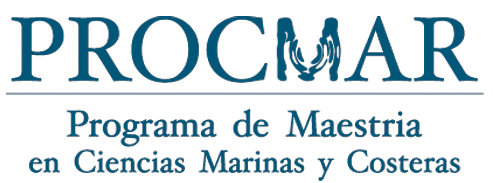|
ISSN: 1659-455X • e-ISSN: 1659-407X REVMAR REVISTA CIENCIAS MARINAS Y COSTERAS
Recepción 30 agosto 2022 • Corregido 05 octubre 2022 First record of the Fiddler Crab, Minuca osa from the Eastern Montijo Gulf, Panama Primer reporte del cangrejo violinista, Minuca osa en el oriente del golfo de Montijo, Panamá Roberto C. Lombardo-González1 ABSTRACT Minuca osa had been previously thought to be endemic to Pacific Costa Rica (Golfo Dulce). However, specimens fitting the description were sampled in April 2021 and August 2022 in two sites in the Eastern Montijo Gulf, Panama. Based on the morphological character correspondence between the specimens collected and the original species description, it can be concluded that Minuca osa is also present in the Eastern Montijo Gulf. Keywords: tuberculate ridge, Uca, dactyl, chela, pollex RESUMEN Anteriormente, se pensaba que Minuca osa era endémica del Pacífico de Costa Rica (golfo Dulce); sin embargo, en abril 2021 y agosto 2022, se colectaron especímenes que se ajustaban a la descripción de la especie en dos sitios del oriente del golfo de Montijo, Panamá. Con base en la correspondencia de caracteres morfológicos, se concluye que Minuca osa también está presente en el oriente del golfo de Montijo. Palabras clave: borde tuberculado, Uca, dáctilo, quela, pollex Fiddler crabs (Ocypodidae: Uca Leach, 1814) are distributed along most tropical and semitropical coastlines of the world (Rosenberg, 2020). Research on fiddler crabs in Panama has been published on various topics, such as, functional morphology in Petruca panamensis, Leptuca terpsichores and L. beebei (Lim & Goh, 2021), vision in L. stenodactylus (see How et al. 2015), sexual selection (Dennenmoser & Christy, 2013), construction of structures (Pardo et al. 2020) in L. terpsichores and L. beebei, and larval ecology in L. terpsichores (Christy, 2003), and L. deichmanni (Kerr, 2015). Even though fiddler crabs are widely distributed in Panama, sampling in all the aforementioned studies was conducted exclusively at the Pacific entrance of the Panama Canal, whereas studies from other provinces are lacking. There are currently 35 recognized fiddler crab species in Panama. On the Atlantic coast, there are seven species, distributed into three genera: Minuca with four species, Uca with two, and a single species of Leptuca (L. thayeri). In the Pacific, there are 28 species grouped into four genera, of which sixteen are in the genus Leptuca, six within Uca, five within Minuca, and a single species of Petruca (P. panamensis) (Rosenberg, 2014). In the Ponuga River, Eastern Montijo Gulf, Veraguas Province, fiddler crabs were observed waving their claw in synchrony. The major claw, bright red-orange with a white tip, was the most striking feature of these fiddler crabs. A species fitting this morphological characteristic was described by Landstorfer & Schubart (2010) from the Golfo Dulce, Pacific coast of Costa Rica (Fig. 1A). The authors named the new species, Minuca osa, and suggested that it might be endemic. Based on geographical proximity of Golfo Dulce and our study area, it seemed plausible that M. osa could also be found in Panama (Fig. 1B, C). Therefore, the objective of this study was to identify the specimens found in the Eastern Montijo Gulf and report on the possible geographical extension of M. osa distribution range. Fig. 1. Geographical context and locations of Minuca osa reports in the Eastern Tropical Pacific. A: sampling site (red) of the specimens in the original description of Minuca osa (Landstorfer & Schubart, 2010). Preliminary images of male (B) and female (C) Minuca osa from the Eastern Montijo Gulf. D: Ponuga (north) and Mata Oscura (south) georeferenced sampling sites (yellow); scale: 1:250,000. UTM projection (Universal Mercator Traverse - 17 N). Horizontal datum: World Geodetic System 1984 (WGS-84). Vertical datum: medium sea level of the WGS-84 geoid Fig. 1. Contexto geográfico y ubicaciones de reportes de Minuca osa en el Pacífico Tropical Oriental. A: sitio de procedencia (rojo) de los especímenes en la descripción original de Minuca osa (Landstorfer & Schubart, 2010). Imágenes preliminares de Minuca osa macho (B) y hembra (C) del oriente del golfo de Montijo. D: Sitios de muestreo georeferenciados de Ponuga (norte) y Mata Oscura (sur) (amarillo); escala: 1:250,000. Proyección UTM (Universal Mercator Traverse - 17 N). Datum horizontal: Sistema Geodésico Mundial 1984 (WGS-84). Datum vertical: Nivel medio del mar del geoide WGS-84 Sampling was conducted on April 27th, 2021, and August 13th and 14th, 2022 at two sites on the Eastern Montijo Gulf (Fig. 1D); the Ponuga River (07° 51ʼ 51.3756ʼʼ N, -081° 00ʼ 52.6248ʼʼ W) and Mata Oscura (07° 27ʼ 29.0124ʼʼ N, -080° 55ʼ 12.8532ʼʼ W). Fiddler crabs (n = 22) were caught by hand, rinsed, and later stored in a freezer unit. Morphological characters of interest were photographed; specimens’ carapace width and length, as well as chela height and length, were measured (mean ± SD; 0.01 mm), and taxonomical keys (Landstorfer & Schubart, 2010; Crane, 2015; Shih et al. 2016; Rosenberg, 2020) were used for the identification of the collected material. Morphological characters between Golfo Dulce (Landstorfer & Schubart, 2010) and the Eastern Montijo Gulf were compared with the t-test. Features of the genus Minuca were found in 22 individuals averaging 21.44 ± 2.96 mm and 14.60 ± 1.62 mm in carapace width and length, respectively; 14 were from Ponuga and eight from Mata Oscura. Specimens were larger than those from Golfo Dulce, except in major chela height, where no difference was detected (Table 1). In general, compared to other Minuca species, sampled individuals from Ponuga and Mata Oscura can be considered large within the genus (Table 2). Table 1. Morphological character comparisons (mm) between Minuca osa specimens collected in the Eastern Montijo Gulf (Panama) and those noted in the original species description by Landstorfer and Schubart (2010) at Golfo Dulce (Costa Rica). EMG: Eastern Montijo Gulf. GD: Golfo Dulce. CW: carapace width. CL: carapace length. QH: major chela height. QL: major chela length Tabla 1. Comparaciones de caracteres morfológicos (mm) entre especímenes de Minuca osa colectados en el oriente del golfo de Montijo (Panamá) y aquellos en la descripción original de la especie por Landstorfer y Schubart (2010) en golfo Dulce (Costa Rica). EMG: Oriente del golfo de Montijo. GD: golfo Dulce. CW: ancho del caparazón. CL: longitud del caparazón. QH: altura de la quela mayor; QL: longitud de la quela mayor
Table 2. Carapace width differences between Minuca osa from the Eastern Montijo Gulf (mean = 21.44 mm), Golfo Dulce (Pacific Costa Rica) and other Minuca species reported in Panama Tabla 2. Diferencias en ancho de caparazón entre especímenes de Minuca osa del oriente del golfo de Montijo (media = 21.44 mm), golfo Dulce (Costa Rica) y otras especies del género Minuca reportadas en Panamá
Morphological characters of the genus found in sampled specimens include: H-like depression in the cardiac-mesogastric region, carapace width to front ratio of approximately 35% (wide front; Fig. 2A), with long anterolateral margins curving inwards (Fig. 2A, D), small suborbital crenulations increasing towards outer angle (Fig. 2B), narrow gape minor chelipeds with small serrations (Fig. 2C), and two postero-lateral striae in the carapace (Fig. 2D).
Fig. 2. Minuca osa diagnostic features from the Eastern Montijo Gulf, Veraguas, Panama. A: carapace. B: orbital cavity. C: minor chelipeds, left female (outer side); right male (inner surface). D: carapace striae. E: pubescence in carpus and propodus of ambulatories. F: ambulatory merus tuberculate ridge. G: ambulatories dactylus setae rows. H: major chela. I: pollex tubercle rows and large carina beyond midpoint. J: large tubercles at pollex tip. K: dactyl edge tubercles. L-M: manus, palm, and pollex tubercular ridges. N: large chela carpus and merus tubercles. O: right gonopod, anterolateral (left) and posteromesial (right). (Scale bar: A, D, I-L, N = 5 mm; B, C, F, G = 2 mm; H, M = 10 mm; E = 0.5 mm; O = 0.2 mm) Fig. 2. Características diagnósticas de Minuca osa del oriente del golfo de Montijo, Veraguas, Panamá. A: caparazón. B: cavidad orbital. C: quelípedos menores, izquierda es hembra (exterior); derecha es macho (interior). D: estrías de caparazón. E: pubescencia y setas en carpio y propodio de ambulatorios. F: borde tubercular en mero ambulatorio. G: setas en dáctilo ambulatorio. H: chela mayor. I: filas de tubérculos del pollex y carina grande, más allá del punto medio. J: tubérculos en punta del pollex. K: borde prensil del dáctilo tuberculado. L-M: crestas tuberculares del manus, palma y pollex. N: tubérculos en carpio y mero de chela mayor. O: gonopodio derecho, anterolateral (izq.) y posteromesial (der.). (Barras de escala: A, D, I-L, N = 5 mm; B, C, F, G = 2 mm; H, M = 10 mm; E = 0.5 mm; O = 0.2mm) A total of 16 males and six females exhibited traits that fit the description of Minuca osa. Specifically, segments of the pleon were not fused, carapace surface with small pits; no pubescence or setae on carapace (Fig. 2A, D). There was pile with few long setae in the ambulatories dorsal margin of the carpus and propodus, in agreement with that reported for M. osa (Fig. 2E). The dorsal margins of ambulatory meri in males had a soft dorsal tuberculate ridge (Fig. 2F); dactyls of ambulatory legs have three distinct rows of short setae (Fig. 2G). In males, the external surface and dorsal edge of the manus was tuberculate, with a minuscule hollow space, proximal to the predactylar groove. Tubers in the major chela diminished on lower manus and were minuscule on pollex and dactyl (Fig. 2H). The pollex was curved upwards at the tip; both, the pollex and dactyl were flattened. The dactyl was longer than the pollex and was curved at approx. 90° downward at tip (Fig. 2H, K, M). The pollex showed three rows of tubercles, and one large carina beyond the midpoint (Fig. 2I). There was one large subdistal tooth at the gape mid-row of the pollex, forming three distinct tubercles (white) on the tip (Fig. 2J, K, M). The dactyl had three to four larger tubercles (Fig. 2K, M). The inner surface of the manus had a ridge of dense tubercles lining the margin of the carpal cavity, warping in direction to the palm with tubercles growing in size and ending in a patch in the central section of the manus, almost connecting to the oblique tuberculate edge (Fig. 2L). The ventral manus tuberculate ridge was oblique with a high apex, sloping into pollex ventral surface. This ridge had distinctive tubercles decreasing in size towards the pollex with increased irregularity. The pollex and manus articulation had a deep sulcus which ran between the pollex ventral margin and two predactylar tuberculate ridges; the nearest was divergent and curled into the inner dorsal tuberculate ridge of the pollex (Fig. 2L, M). The carpal surface (dorsal) of major chelipeds bearded four to five sharp tubers, and the merus showed numerous sharp tubercles on the dorsal edge (Fig. 2N). The gonopod had two flanges and a thumb; the posterior flange was longer than the anterior. The genital pore and flanges were covered by extension of the shaft. Setae were on the opposite side of the flanges, on thumb and tip of gonopod (Fig. 2O). Minuca burgersi, M. vocator, and M. ecuadoriensis are morphologically similar to M. osa (Landstorfer & Schubart, 2010; Rosenberg, 2020); however, M. burgersi and M. vocator are only distributed in the Western Atlantic, while M. ecuadoriensis is only found in the Eastern Pacific (Masunari et al. 2020; Rosenberg, 2020). Furthermore, M. burgersi also differs from our specimens in that the oblique tuberculate ridge on the major palm has small tubercles (not a single row); tubercle ridge does not diminish distally on outer pollex (Crane, 2015; Shih et al. 2016). In Minuca vocator and M. ecuadoriensis, the carapace as well as the ambulatories on all segments have a profuse pile (except dactyls) in an irregular pattern (see Masunari et al. 2020), while our specimens had no such pile. In M. ecuadoriensis, the oblique ridge in the major palm has a very low apex; tubercles are small and irregular, sometimes vestigial or absent. In contrast, the apex in M. osa is high and tubercles are large (Landstorfer & Schubart, 2010; Crane, 2015); all of our specimens showed the latter. Considering its behavior and coloration, M. osa is a conspicuous fiddler crab species; thus, it is unclear why it was not been identified other than in Golfo Dulce (Landstorfer & Schubart, 2010) prior to this report. Based on the morphological differences between M. osa, M. burgersi, M. vocator, and M. ecuadoriensis, it can be concluded that M. osa is also present in the Eastern Montijo Gulf, Panama. Our gratitude goes to the anonymous reviewers for their comments to improve the manuscript and to John Christy and Fumio Takeshita for their preliminary discussions. We would also like to thank Jaime Rivera for his cartographic assistance, as well as Jacinto Rodríguez and the Cantarana Hotel staff for their hospitality. Benetti, A. S. & Negreiros-Fransozo, M. L. (2003). Symmetric chelipeds in males of the fiddler crab Uca burgersi Holthuis, 1967 (Decapoda, Brachyura, Ocypodidae). Nauplius, 11(2), 141-144. Christy, J. H. (2003). Reproductive timing and larval dispersal of intertidal crabs: the predator avoidance hypothesis. Rev. Chil. Hist. Nat., 76(2), 177-185. https://doi.org/10.4067/S0716-078X2003000200005 Crane, J. (1975). Fiddler Crabs of the World: Ocypididae: Genus Uca (1st ed.). USA. Princeton: Princeton University Press. https://doi.org/10.1515/9781400867936 Dennenmoser, S. & Christy, J. H. (2013). The design of a beautiful weapon: Compensation for opposing sexual selection on a trait with two functions. Evolution, 67(4), 1181-1188. https://doi.org/10.1111/evo.12018 How, M. J., Christy, J. H., Temple, S. E., Hemmi, J. M., Marshall, J. N. & Roberts, N. W. (2015). Target detection is enhanced by polarization vision in a fiddler crab. Curr. Biol., 25(23), 3069-3073. https://doi.org/10.1016/j.cub.2015.09.073 Jones, A. R. (1980). Chela injuries in the fiddler crab, Uca burgersi holthuis. Mar. Behav. Physiol., 7(1), 47-56. https://doi.org/10.1080/10236248009386970 Juarrero de Varona, A. & Ortiz, M. (2003). Los cangrejos del género Uca (Crustacea: Brachyura: Ocypodidae) en Cuba. Apuntes taxonómicos. Cocuyo, 13, 7-10. Kerr, K. A. (2015). Decreased temperature results in daytime larval release by the fiddler crab Uca deichmanni Rathbun, 1935. J. Crustac. Biol., 35(2), 185-190. https://doi.org/10.1163/1937240X-00002334 Koch, V., Wolff, M. & Diele, K. (2005). Comparative population dynamics of four fiddler crabs (Ocypodidae, genus Uca) from a North Brazilian mangrove ecosystem. Mar. Ecol. Prog. Ser., 291, 177-188. https://doi.org/ 10.3354/meps291177 Landstorfer, R. B. & Schubart, C. D. (2010). A phylogeny of Pacific fiddler crabs of the subgenus Minuca (Crustacea, Brachyura, Ocypodidae: Uca) with the description of a new species from a tropical gulf in Pacific Costa Rica. J. Zool. Syst. Evol. Res., 48(3), 213-218. https://doi.org/10.1111/j.1439-0469.2009.00554.x Lim, S. S. L. & Goh, S. J. A. (2021). Ecomorphological adaptations of second maxilliped-setation: Insights from three species of fiddler crabs from Panama. Zool. Stud., 60, 1-10. https://doi.org/10.6620/ZS.2021.60-48 Masunari, S., Martins, S. B. & Anacleto, A. F. M. (2020). An illustrated key to the fiddler crabs (Crustacea, Decapoda, Ocypodidae) from the Atlantic coast of Brazil. ZooKeys, 943, 1-20. https://doi.org/10.3897/zookeys.943.52773 Pardo, J. C. F., Stefanelli-Silva, G., Christy, J. H. & Costa, T. M. (2020). Fiddler crabs and their above-ground sedimentary structures: a review. J. Ethol., 38(2), 137-154. https://doi.org/10.1007/s10164-020-00647-1 Rosenberg, M. S. (2014). Contextual cross-referencing of species names for Fiddler Crabs (Genus Uca): an experiment in cyber-taxonomy. PLoS ONE, 9(7), e101704. https://doi.org/10.1371/journal.pone.0101704 Rosenberg, M. S. (2020). A fresh look at the biodiversity lexicon for fiddler crabs (Decapoda: Brachyura: Ocypodidae). Part 2: Biogeography. J. Crust. Biol., 40(4), 364-383. https://doi.org/10.1093/jcbiol/ruaa029 Shih, H., Ng, P., Davie, P., Schubart, C., Türkay, M., Naderloo, R., … & Liu, M. (2016). Systematics of the family Ocypodidae Rafinesque, 1815 (Crustacea: Brachyura), based on phylogenetic relationships, with a reorganization of subfamily rankings and a review of the taxonomic status of Uca Leach, 1814, sensu lato and its subgenera. Raffles Bull. Zool., 64, 139-175. 1 Universidad de Panamá, Centro Regional Universitario de Veraguas. Centro de Capacitación, Investigación y Monitoreo de la Biodiversidad en el Parque Nacional Coiba. roberto.lombardo@up.ac.pa* ORCID: https://orcid.org/0000-0002-0279-8621 |
/revmar14-2.jpg)
/Art-2_Fig-1.jpg)
/Art-2_Fig-2.jpg)




